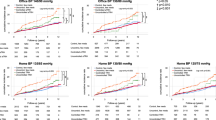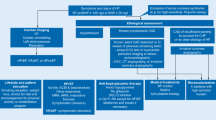Abstract
Silent myocardial ischemia (SMI) is frequently observed in patients with essential hypertension (EH). The major risk factor for SMI is uncontrolled blood pressure (BP), but SMI is also observed in patients with well-controlled BP. To evaluate the prevalence of SMI and the factors associated with SMI in EH patients with well-controlled BP. The medical records of 859 EH patients who underwent simultaneous 24-h ambulatory blood pressure monitoring (ABPM) and 24-h ambulatory electrocardiogram recording (AECG) were retrospectively evaluated. Each SMI episode was characterized by: (a) ST segment depression ≥0.5 mm; (b) duration of ST segment depression >60 s; and (c) reversibility of the ST segment depression. Overall 126 EH patients (14.7 %) had at least one episode of SMI. The SMI events were more frequent among patients with poorly controlled compared to those with well-controlled BP [86/479 (17.95 %) vs. 40/380 (10.52 %), p < 0.01]. Among EH patients with well-controlled BP, current and past smoking as well as the presence of an additional metabolic syndrome (MetS) constitutive element (obesity, impaired fasting glucose level or dyslipidemia) were significantly associated with the occurrence of SMI. In all EH patients with well-controlled BP and AECG evidence of SMI, there were one or more coronary artery stenotic lesions greater than 50 % found at coronary angiography. In EH patients who are current smokers, or have one or more additional components of a MetS there is markedly reduced benefit associated with good BP control with regard to the occurrence of myocardial ischemia: in this patient category, an AECG may help detect this condition.



Similar content being viewed by others
References
Conti C, Bavry AA, Petersen JW (2012) Silent ischemia clinical relevance. J Am Coll Cardiol 59:435–441
Wimmer NJ, Scirica BM, Stone PH (2013) The clinical significance of continuous ECG (ambulatory ECG or Holter) monitoring of the ST-segment to evaluate ischemia: a review. Prog Cardiovasc Dis 56:195–202
Gutterman DD (2009) Silent myocardial ischemia. Circ J 73:785–797
Cohn PF, Fox KM (2003) Silent myocardial ischemia. Circulation 108:1263–1277
Margolis JR, Kannel WB, Feinleib M et al (1973) Clinical features of unrecognized myocardial infarction silent and symptomatic. Am J Cardiol 32:1–7
Kannel WB (1986) Silent myocardial ischemia and infarction: insights from the Framingham study. Cardiol Clin 4:583–591
Deedwania PC, Carbajal EV (1990) Silent ischemia during daily life is an independent predictor of mortality in stable angina. Circulation 81:748–756
Pepine CJ, Geller NL, Knatterud GL et al (1994) The asymptomatic cardiac ischemia pilot (ACIP) study: design of a randomized clinical trial, baseline data and implications for a long-term outcome trial. J Am Coll Cardiol 24:1–10
Mirvis DM, El-Zeky F, VanderZwaag R et al (1990) Clinical and pathophysiologic correlates of ST-T-wave abnormalities in coronary artery disease. Am J Cardiol 66:699–704
Asmar R, Benetos A, Panier B et al (1996) Prevalence and circadian variation of ST-segment depression and its concomitant blood pressure changes in asymptomatic systemic hypertension. Am J Cardiol 77:384–390
Stramba-Badiale M, Bonazzi O, Casadei G et al (1998) Prevalence of episodes of ST-segment depression among mild to moderate hypertensive patients in northern Italy: the cardioscreen study. J Hypertens 16:681–688
Zehender M, Meinertz T, Hohnloser S et al (1992) Prevalence of circadian variations and spontaneous variability of cardiac disorders and ECG changes suggestive of myocardial ischemia in systemic arterial hypertension. Circulation 85:1808–1815
Boon D, Piek JJ, van Montfrans GA (2000) Silent ischemia and hypertension. J Hypertens 18:1355–1364
Hedblad B, Janzon L (1992) Hypertension and ST-segment depression during ambulatory electrocardiographic recording. Hypertension 20:30–77
Nadir MA, Rekhraj S, Wei L et al (2012) Improving the primary prevention of cardiovascular events by using biomarkers to identify individuals with silent heart disease. J Am Coll Cardiol 60:960–968
Rendina D, De Filippo G, Mossetti G et al (2012) Relationship between metabolic syndrome and multinodular non-toxic goiter in an inpatient population from a geographic area with moderate iodine deficiency. J Endocrinol Invest 35:407–412
Rendina D, Mossetti G, De Filippo G et al (2009) Association between metabolic syndrome and nephrolithiasis in an inpatient population in southern Italy: role of gender, hypertension and abdominal obesity. Nephrol Dial Transplant 24:900–906
European Society of Hypertension-European Society of Cardiology Guidelines Committee (2003) 2003 European Society of Hypertension–European Society of Cardiology guidelines for the management of arterial hypertension. J Hypertens 21:1011–1053
Mancia G, De Backer G, Dominiczak A et al (2007) 2007 guidelines for the management of arterial hypertension: the task force for the management of arterial hypertension of the European Society of Hypertension (ESH) and of the European Society of Cardiology (ESC). J Hypertens 25:1105–1187
O’Brien E, Asmar R, Beilin L et al (2003) European Society of Hypertension recommendations for conventional, ambulatory and home blood pressure measurement. J Hypertens 21:821–848
Meek S, Morris F (2002) ABC of clinical electrocardiography. Introduction. I-Leads, rate, rhythm, and cardiac axis. BMJ 324:415–418
Goodacre S, Irons R (2002) ABC of clinical electrocardiography: atrial arrhythmias. BMJ 324:594–597
Esberger D, Jones S, Morris F (2002) ABC of clinical electrocardiography. Junctional tachycardias. BMJ 324:662–665
Ehler D, Carney DK, Dempsey AL et al (2001) Guidelines for cardiac sonographer education: recommendations of the American Society of Echocardiography Sonographer Training and Education Committee. J Am Soc Echocardiogr 14:77–84
Gallotta G, Palmieri V, Piedimonte V et al (2008) Increased troponin I predicts in-hospital occurrence of hemodynamic instability in patients with sub-massive or non-massive pulmonary embolism independent to clinical, echocardiographic and laboratory information. Int J Cardiol 124:351–357
http://www.royalcollege.ca/portal/page/portal/rc/common/documents/exams/normal_values_e.pdf. Accessed 31 Mar 2016
Mancia G, Fagard R, Narkiewicz K et al (2013) 2013 ESH/ESC guidelines for the management of arterial hypertension: the Task Force for the Management of Arterial Hypertension of the European Society of Hypertension (ESH) and of the European Society of Cardiology (ESC). Eur Heart J 34:2159–2219
Mitchell GF, Moyé LA, Braunwald E, SAVE investigators et al (1997) Sphygmomanometrically determined pulse pressure is a powerful independent predictor of recurrent events after myocardial infarction in patients with impaired left ventricular function. Survival and ventricular enlargement. Circulation 96:4254–4260
Schutte R, Thijs L, Asayama K et al (2013) Double product reflects the predictive power of systolic pressure in the general population: evidence from 9,937 participants. Am J Hypertens 26:665–672
Kadish AH, Buxton AE, Kennedy HL et al (2001) ACC/AHA clinical competence statement on electrocardiography and ambulatory electrocardiography: a report of the ACC/AHA/ACP-ASIM task force on clinical competence (ACC/AHA Committee to develop a clinical competence statement on electrocardiography and ambulatory electrocardiography) endorsed by the International Society for Holter and non-invasive electrocardiology. Circulation 104:3169–3178
Rocco MB, Nabel E, Selwyn AP (1986) Development and validation of ambulatory monitoring to characterize ischemic heart disease out of hospital. Cardiol Clin 4:659–668
Deanfield JE, Shea MJ, Ribiero P et al (1984) Transient ST-segment depression as a marker of myocardial ischemia during daily life. Am J Cardiol 54:1195–1200
Grundy SM, Cleeman JI, Daniels SR et al (2005) Diagnosis and management of the metabolic syndrome: an American Heart Association/National Heart, Lung, and Blood Institute Scientific Statement. Circulation 112:2735–2752
Gibbons RJ, Balady GJ, Bricker JT et al (2002) ACC/AHA 2002 guideline update for exercise testing: summary article. A report of the American College of Cardiology/American Heart Association Task Force on Practice Guidelines (Committee to update the 1997 exercise testing guidelines). Circulation 106:1883–1892
Foley DP, Escaned J, Strauss BH et al (1994) Quantitative coronary angiography (QCA) in interventional cardiology: clinical application of QCA measurements. Prog Cardiovasc Dis 36:363–384
Li J, Hua Q, Pi L et al (2010) Circadian variation on the onset of acute ST segment elevation myocardial infarction in diabetic subjects. J Cardiovasc Dis Res 1:23–26
D’Negri CE, Nicola-Siri L, Vigo DE et al (2006) Circadian analysis of myocardial infarction incidence in an Argentine and Uruguayan population. BMC Cardiovascular Disord 6:1
Willich SN, Linderer T, Wegscheider K et al (1989) Increased morning incidence of myocardial infarction in the ISAM Study: absence with prior beta-adrenergic blockade. ISAM Study Group. Circulation 80:853–858
Uen S, Baulmann J, Düsing R et al (2003) ST-segment depression in hypertensive patients is linked to elevations in blood pressure, pulse pressure and double product by 24-h Cardiotens monitoring. J Hypertens 21:977–983
Zidek W, Naditch-Brûlé L, Perlini S et al (2009) Blood pressure control and components of the metabolic syndrome: the GOOD survey. Cardiovasc Diabetol 8:51
Rocco MB, Barry J, Campbell S et al (1987) Circadian variation of transient myocardial ischemia in patients with coronary artery disease. Circulation 75:395–400
Muller JE, Ludmer PL, Willich SN et al (1987) Circadian variation in the frequency of sudden cardiac death. Circulation 75:131–138
Morris JJ Jr (1990) Mechanisms of ischemia in coronary artery disease: spontaneous decrease in coronary blood supply. Am Heart J 120:746–756
Panza JA, Epstein SE, Quyyumi AA (1991) Circadian variation in vascular tone and its relation to alpha-sympathetic vasoconstrictor activity. N Engl J Med 325:986–990
Uen S, Un I, Fimmers R, Vetter H et al (2006) Myocardial ischemia during everyday life in patients with arterial hypertension: prevalence, risk factors, triggering mechanism and circadian variability. Blood Press Monit 11:173–182
Melina D, Colivicchi F, Melina G et al (1993) Prevalence of silent ST segment depression during long-term ambulatory electrocardiographic monitoring in asymptomatic diabetic patients with essential hypertension. Minerva Med 84:301–305
Boon D, van Goudoever J, Piek JJ et al (2003) ST segment depression criteria and the prevalence of silent cardiac ischemia in hypertensives. Hypertension 41:476–481
Sapin PM, Koch G, Blauwet MB et al (1991) Identification of false positive exercise tests with use of electrocardiographic criteria: a possible role for atrial repolarization waves. J Am Coll Cardiol 18:127–135
Takach TJ, Glassman LR, Ribakove GH et al (1986) Continuous measurement of intramyocardial pH: correlation to functional recovery following normothermic and hypothermic global ischemia. Ann Thorac Surg 42:31–36
Stagmo M, Juul-Möller S, Israelsson B (2005) Fifteen-year risk of major coronary events predicted by Holter ST-monitoring in asymptomatic middle-aged men. Eur J Cardiovasc Prev Rehabil 2:478–483
De Lorenzo A (2015) Screening for silent coronary artery disease in diabetics- or not? Curr Diabetes Rev 11:98–101
Veillet-Chowdhury M, Blankstein R (2015) Is there a role for screening asymptomatic patients with diabetes? Expert Rev Cardiovasc Ther 13:589–591
Struthers AD (2013) A new approach to residual risk in treated hypertension–3P screening. Hypertension 62:236–239
Thomopoulos C, Parati G, Zanchetti A (2014) Effects of blood pressure lowering on outcome incidence in hypertension: 3. Effects in patients at different levels of cardiovascular risk–overview and meta-analyses of randomized trials. J Hypertens 32:2305–2314
Acknowledgments
The authors are grateful to the owners and the medical director of the Spinelli Hospital who granted the free use of the facilities and services required to conduct the study. This study was supported by unrestricted grants from Stroder/Società Italiana dell’Osteoporosi del Metabolismo Minerale e delle Malattie dello Scheletro (to DR) and Società Italiana Medicina Interna (to RI).
Author information
Authors and Affiliations
Corresponding author
Ethics declarations
Conflict of interest
The authors declare that they have no conflict of interest.
Statement of human and animal rights
All the clinical procedures were conducted in accordance with the Declaration of Helsinki on human experimentation. The study protocol has been approved by the Federico II University Hospital Ethical Committee.
Informed consent
Informed consent was obtained from all individual participants included in the study.
Electronic supplementary material
Below is the link to the electronic supplementary material.
Rights and permissions
About this article
Cite this article
Rendina, D., Ippolito, R., De Filippo, G. et al. Risk factors for silent myocardial ischemia in patients with well-controlled essential hypertension. Intern Emerg Med 12, 171–179 (2017). https://doi.org/10.1007/s11739-016-1527-2
Received:
Accepted:
Published:
Issue Date:
DOI: https://doi.org/10.1007/s11739-016-1527-2




